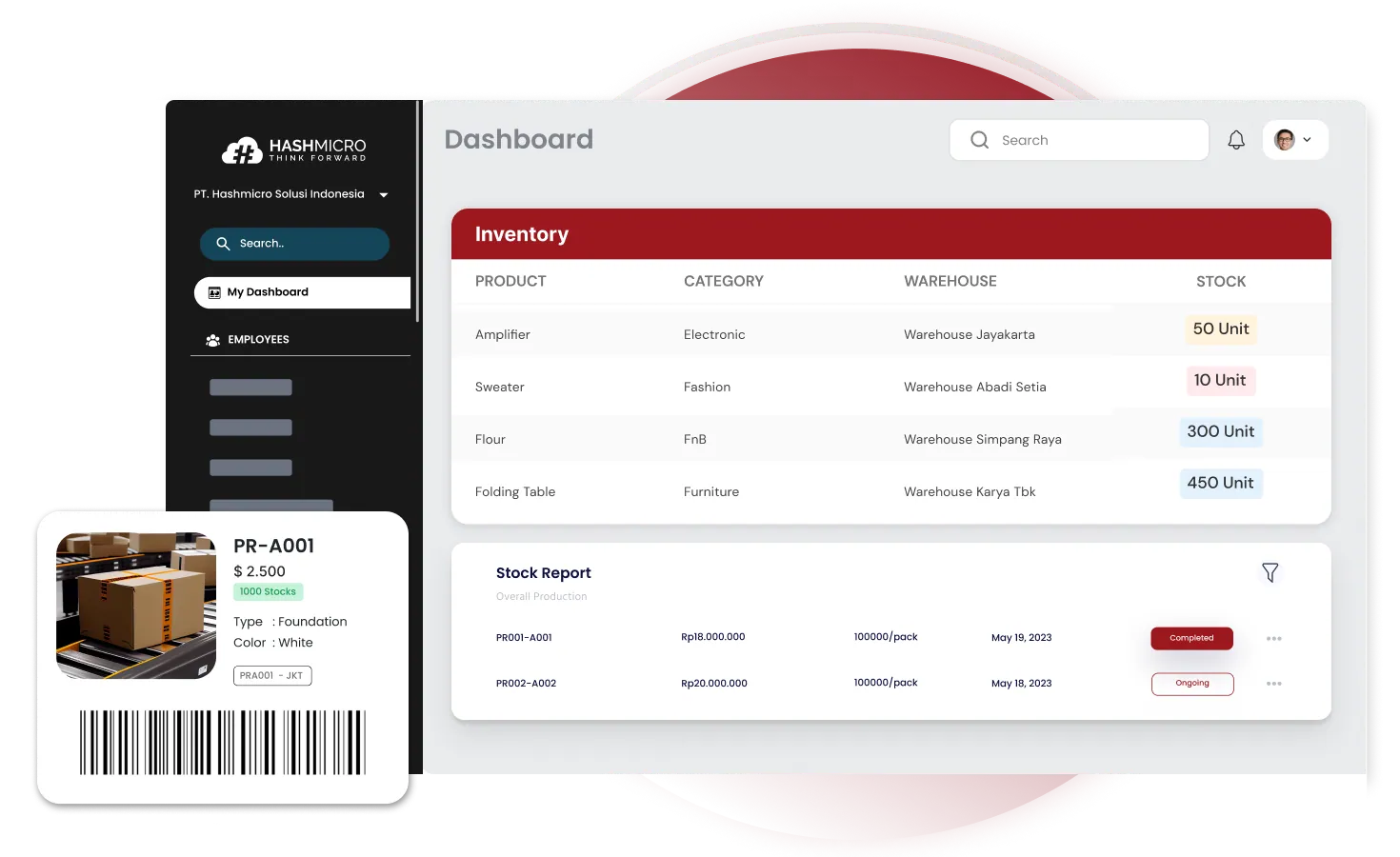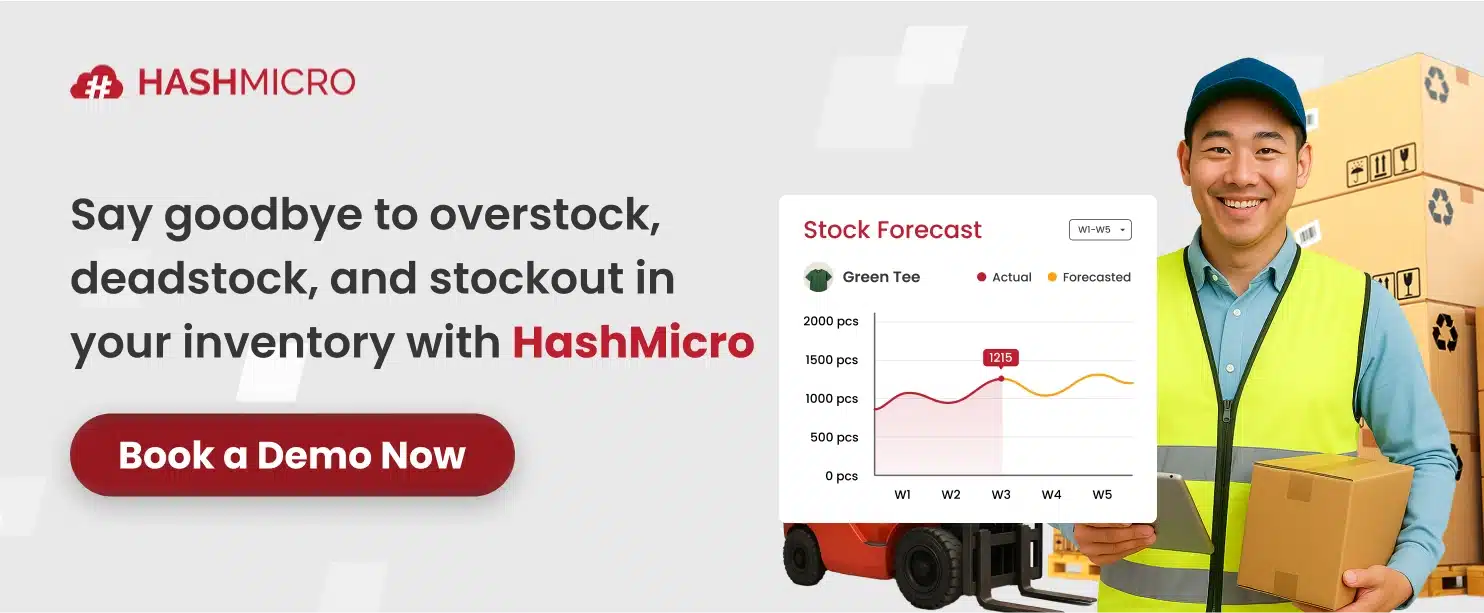Obsolescence inventory refers to stock that loses value due to low demand, expired shelf life, or market changes. From my experience, unmanaged obsolete items can quickly drain resources and impact profitability.
In Q2 2024, Singapore’s business inventories rose by 921.3 million SGD, highlighting the risks of overstocking and obsolescence that many companies face today. That’s why having real-time insights into stock movement is crucial.
With HashMicro Inventory Management Software, I can easily monitor stock levels, automate reordering, and track product lifecycles to prevent obsolescence. Get your free demo today and discover how this system can help you optimize your inventory management.
Key Takeaways
|
What is Obsolete Inventory?
Obsolete inventory is stock that can no longer be sold or used due to expired demand, outdated technology, or market shifts. It ties up storage space and working capital, increasing costs and potentially harming business profitability.
I’ve seen firsthand how obsolete inventory can consume valuable warehouse space and lock up capital that could be used for growth. It also increases storage expenses and often requires extra effort for proper disposal.
To minimize obsolescence, I rely on advanced inventory software that helps me track product lifecycles, forecast demand accurately, and detect slow-moving stock before it becomes unsellable.
By managing obsolete inventory effectively, I can maintain smoother operations, reduce waste, and ensure better financial performance for the business.
How Obsolescence Inventory Works
From my experience, inventory obsolescence happens when products become unsellable or unusable due to shifts in market demand, expiration, or rapid technological change. As consumer preferences evolve and new products emerge, older inventory often loses its value.
I usually notice the process beginning when product demand starts to decline. Items sit on the shelves longer, take up storage space, and become obsolete. That’s why I regularly assess stock performance and forecast demand to prevent overstocking.
To minimize losses, I often use strategies like offering discounts or repurposing old inventory. With the help of an advanced inventory management system, I can easily track product lifecycles and prevent the buildup of obsolete stock.
How to Identify Obsolete Inventory
Identifying obsolete inventory has always been one of my top priorities in maintaining efficient operations. By combining the right tools and regular analysis, I can quickly spot slow-moving items before they turn into costly excess stock.
- Use technology to track slow-moving items: Implement inventory management tools to identify products that are not selling quickly.
- Conduct regular inventory audits: Routine checks help detect obsolete stock early, preventing profit loss and excess storage costs.
- Take proactive actions: Decide whether to run flash sales or donate items to clear outdated stock.
- Leverage data-driven insights: Analyze inventory days on hand, sales patterns, and purchase trends to make smarter restocking or discontinuation decisions.
Benefits of Getting Rid of Obsolete Inventory
From my experience, removing obsolete inventory brings major improvements to business performance. It helps me streamline daily operations, cut unnecessary expenses, and make better use of available resources. Here are the key benefits I’ve observed when removing obsolete inventory:
1. Free up valuable storage space
By eliminating obsolete inventory, businesses can make room for more relevant and high-demand products. This leads to better inventory organization, optimized warehouse space, and easily accessible products, which improves overall operational efficiency.
3. Improve cash flow and capital utilization
Removing unsellable goods releases capital that was previously tied up in obsolete inventory. This freed-up capital can be reinvested into more profitable products or other business areas, improving cash flow and contributing to business growth.
4. Lower storage and maintenance costs
Keeping obsolete inventory in storage incurs additional maintenance, management, and space usage costs. By clearing out outdated stock, businesses reduce these ongoing expenses and prevent further losses, enabling them to maintain a leaner, more efficient inventory system.
Causes of Excess and Obsolete Inventory
From what I’ve seen, excess and obsolete inventory often come from poor inventory planning or sudden market shifts. Understanding these causes helps me minimize losses and keep stock levels under control. Here are the main factors behind them:
1. Overproduction and overordering
One of the leading causes of excess inventory is overproduction or overordering, often due to inaccurate demand forecasting. When businesses produce or purchase more stock than needed, surplus inventory can result that eventually becomes obsolete, especially if demand decreases.
A cloud-based inventory system can help mitigate this issue by providing real-time data and analytics, allowing businesses to better predict demand and avoid overstocking.
2. Changes in consumer preferences
Shifts in consumer preferences or market trends can quickly make products obsolete. Businesses must stay updated on market demands to avoid having unsellable inventory that no longer aligns with customer interests, leading to excess stock.
3. Inefficient inventory management
Inventory management practices, such as proper tracking or lack of visibility, can prevent businesses from overstocking certain items. Without regular inventory audits or accurate forecasting, businesses may hold onto outdated or slow-moving products.
4. Expiration of shelf life
In food, cosmetics, and pharmaceutical industries, products may become obsolete once their shelf life expires. Businesses that do not efficiently manage their stock or rotate inventory properly may end up with expired products that cannot be sold.
5. Technological advancements
Rapid technological changes can quickly render products obsolete in industries like electronics or fashion. Newer models or versions may replace older ones, leaving businesses with excess inventory that no longer meets market demands.
Businesses can reduce stock-related losses and enhance operational efficiency by improving forecasting, inventory management, and staying attuned to market changes.
Effective Ways to Deal with Obsolete Inventory
From my experience, handling obsolete inventory effectively is key to sustaining profitability and smooth operations. By taking proactive steps, I can reduce financial losses and recover value from outdated stock. Here are the best ways I manage obsolete inventory:
1. Discounting and promotions
Offering discounts or running promotional campaigns can help move obsolete inventory. By reducing the price of slow-moving products, businesses can attract price-sensitive customers and clear out outdated stock without incurring significant losses.
2. Repurpose or reuse inventory
Another effective strategy is to repurpose obsolete inventory. This could involve using the products for other purposes within the business, such as using outdated components in production or donating items for charitable causes.
3. Return or exchange with suppliers
Sometimes, businesses can negotiate with suppliers to return unsold or obsolete inventory. Many suppliers offer return or exchange policies, especially for products that are no longer in demand. This option allows businesses to recover some of the costs associated with obsolete stock.
4. Sell to liquidators
Liquidation involves selling obsolete inventory to third-party liquidators, who purchase the stock at a discounted price. Liquidators often deal with overstocked or outdated goods and sell them through discount outlets.
5. Inventory audits and forecasting
Regular inventory audits and improved demand forecasting can help businesses avoid accumulating obsolete stock in the first place. By keeping track of inventory levels and identifying slow-moving items early, businesses can take corrective actions before stock becomes obsolete, such as adjusting orders or implementing targeted promotions.
By implementing these strategies, businesses can effectively manage obsolescence inventory journal entries, minimize financial losses, and improve overall stock management. Regular monitoring and proactive planning are key to preventing future issues with unsellable goods.
Example of Obsolete Inventory

From my experience, recognizing examples of obsolete inventory helps me understand potential challenges and plan better prevention strategies. Here are some common cases I’ve encountered across various industries:
1. Outdated electronics
Due to rapid technological advancements, products like older smartphones, laptops, or other gadgets can quickly become obsolete. For example, a retailer may struggle to sell a previous-generation smartphone once a newer model with better features is released.
2. Expired food products
In the food industry, inventory with a limited shelf life often becomes unsellable once the expiration date passes. For instance, perishable goods such as dairy products, bread, or fresh produce not sold in time turn into obsolete inventory.
3. Fashion items from past seasons
In the fashion industry, clothing or accessories that belong to previous seasons often lose relevance and demand. A store may have an unsold inventory of winter jackets or last year’s trendy designs that are no longer in demand in the current market.
4. Obsolete spare parts
Spare parts for discontinued machinery or vehicles can become obsolete in manufacturing or automotive industries. For example, a car manufacturer may hold spare parts for a model that is no longer in production, resulting in excess inventory.
5. Specialty products with low demand
Niche items that cater to a particular market often face the risk of becoming obsolete if demand drops. For instance, custom-designed packaging materials or promotional items for a past event can no longer be sold or reused.
Recognizing these examples helps businesses identify and address obsolete inventory more effectively. Businesses can avoid accumulating such items and minimize potential losses by implementing strategies such as demand forecasting and inventory audits.
Efficiently Manage Inventory and Reduce Obsolescence with HashMicro

In my experience, managing inventory efficiently can be challenging, especially when dealing with excess or obsolete stock. That’s why I rely on HashMicro’s Inventory Management Software, which provides a complete solution to streamline inventory processes and prevent obsolescence.
With its advanced technology and automation, I can easily optimize stock levels, track every movement, and make smarter, data-driven decisions. Here are some of the key features I find most valuable in HashMicro’s Inventory Management System:
- RFID Warehouse Rack Stock In-Out Automation: This system automates the tracking of stock movement in and out of racks using RFID technology, ensuring real-time updates and reducing manual errors.
- 3D Warehouse: Offers a 3D visualization of the warehouse layout, enhancing stock location monitoring and optimizing space utilization.
- OCR for Receiving: Uses Optical Character Recognition (OCR) to extract data from invoices or delivery notes, automating data entry and ensuring accuracy.
- Stock Forecasting: Predicts inventory needs using historical data and trends, helping to maintain optimal stock levels and prevent overstock or stockouts.
- Run Rate Reordering Rules: Automates reordering by setting thresholds based on consumption rates, ensuring timely stock replenishment.
- Quality Control Management: Simplifies quality checks for incoming and outgoing goods, ensuring all inventory meets required standards.
“Obsolescence inventory is more than just outdated stock; it’s tied-up capital and lost opportunities. By detecting slow-moving items early, businesses can free up cash flow. Smart inventory systems with analytics make this process faster and more accurate.”
— Angela Tan, Regional Manager
Conclusions
Managing obsolete inventory is crucial for businesses to minimize losses and optimize storage space. Companies can effectively address this challenge by implementing demand forecasting, timely stock audits, and clear disposal plans.
Companies can effectively address this challenge by implementing demand forecasting, timely stock audits, and clear disposal plans.
From my experience, HashMicro Inventory Management Software has greatly improved how I handle inventory challenges. Its advanced features, like RFID automation, stock forecasting, and quality control, help me maintain optimal stock levels while minimizing waste and inefficiencies.
I’ve seen firsthand how it transforms inventory operations and boosts overall productivity. Take control of your inventory today and prevent obsolescence with HashMicro’s system. Schedule a free demo to experience how it can elevate your business efficiency!
FAQ About Obsolescence Inventory
-
What is the KPI for obsolete inventory?
The Stock Obsolescence Rate is an essential KPI that indicates the proportion of inventory rendered obsolete or unusable within a given timeframe. Monitoring this metric provides businesses with early insights into product lifecycles and evolving market trends.
-
What are the 3 types of obsolescence?
In commercial real estate investments, obsolescence is classified into three types: functional, economic, and physical. It can be further categorized as curable, meaning it can be resolved, or incurable, indicating it cannot be remedied.
-
How is obsolescence calculated?
Ideally, the total fair value of a company’s assets (e.g., net working capital, fixed assets, and intangible assets excluding goodwill) should be less than the purchase price, with the difference accounted for as goodwill.













